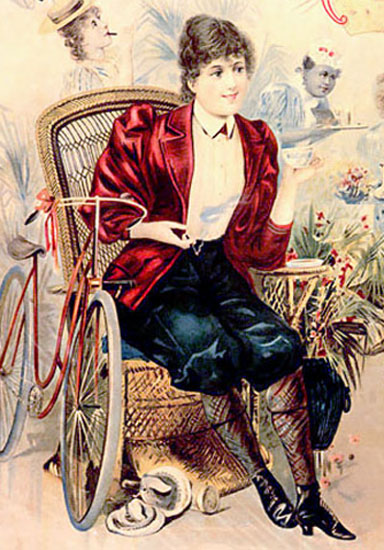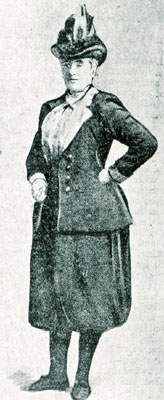A “bulky” dress code
Amélia Bloomer, suffragette and promoter of women’s cycling

In the mid-19th century, Western women’s fashions were far from flattering, comfortable, and practical. Elegance was defined by tiny waists, long corsets which stifled breathing and circulation, metres of skirts and petticoats restricting movement, and heavy hats requiring superior balancing skills. Women suffered from fainting, headaches and anaemia.
In those times when bicycles were too expensive for the working classes, upper class English ladies, sensitive to fashion conventions, stayed away from bicycles which were impractical and dangerous, even though some manufacturers offered models suitable for women and their skirts. In England, cycling as a sport was clearly reserved for young, fearless men.
In the United States, bicycle manufacturers offered women’s models. Driving schools excluding men opened in New York and Boston, and Scientific American magazine backed the initiative.
Again, cycling was closely related to the dress code, as shown in 1849 when Amelia Bloomer and Elizabeth Stanton, two suffragettes, regularly spoke out against bulky skirts in the new women’s liberation newsletter, the “Lily”. In 1851 they were visited in Seneca Falls, New York, by Libby Miller, who arrived on a bicycle, wearing pants. These baggy pants were later dubbed “bloomers”, despite repeated efforts by Ms. Bloomer to credit the real inventor (3).
In 1895, bloomers were common in America and adopted as the apparel for women’s cycling clubs. They appeared in advertising, and dances were held for ladies in bloomers and their companions. In France, in 1868, women straddled bicycles, wearing baggy lacey pants, and were thought to be rather daring.
Pedaling on… despite public opinion
Apparently in 1869, women pedalled gaily through the streets and parks of Paris, sparking comment, but not scandal (4). In Victorian England, women were champing at the bit. With the growing popularity of outings on bicycles among men, their wives and sisters felt they were missing something, especially when the men arrived back on Sunday night, describing an exciting weekend filled with adventure and discovery. But public opinion held that cycling was not feminine, was harmful to women’s health, morals and reputation.
On the other hand, skirts weren’t a problem when pedalling a tricycle or a side-by-side. Despite efforts to discourage them, well-to-do ladies took matters into their own hands and about 1880, began riding tricycles. Chaperon associations formed to properly escort them. Even Queen Victoria’s interest in the tricycle didn’t silence those opposed. In any case, the diehard women cyclists stubbornly continued on towards full acceptance later on. (5)
For sure, skirts sometimes got stuck in the drive train, embarrassing the rider! In 1880, upset that women’s wear still wasn’t suited to the sport, Lady Florence Harberton founded the “Rational Dress Society” dedicated to ridding women of excessive garments and asserting their right to a clothing code allowing more movement. She proposed “trousers” – stylish baggy pants with cuffs just below the knee. Men scoffed at the idea, but the worst enemies of “rational dress” were affluent women cyclists protesting against such outfits. They feared a drastic change in apparel could threaten the reputation of cycling and even take away their right to pedal (6).

Bicyle becomes accessible


The arrival of the Safety (a more practical bicycle with two identical wheels, inflatable tires and pedals) changed everything. In 1889, Starley Brothers produced the ladies’ Rover bicycle for ladies, with a low frame and skirt guard. Costing much less than previous models, less wealthy ladies not bound by all the social restrictions could afford it. Soon old-fashioned tricycles were a thing of the past, and impatient women pedalled off on their new bicycles, despite criticism in the newspapers.
Skirts became shorter, “with less dung and spit brought home in their folds,” argued the more progressive-minded, and if you caught a glimpse underneath, multiple undergarments had ceased to exist, left at home, and replaced by “knickers”! The first women’s club was a cycling club called the ” Coventry Lady Cyclists,” formed in 1892 (7). Women were stepping out!
The following year, together with some male companions, the courageous Tessie Reynolds wore “rational dress” to cycle from London to Brighton and back (176 km in 8.5 hours), on a man’s bicycle, The press caught wind of her exploit, making Reynolds a martyr to the cause and popular opinion covered the spectrum (8). Women’s cycling became such a symbol of freedom that in 1897 Cambridge University students protested against admitting women into the undergraduate program, and hung an effigy of a woman, “rational dress” and bicycle in front of the Senate House (9)!
Many women acquired a taste for freedom thanks to biking, cycling magazines cheered them on and their numbers increased despite the detractors. Around 1895, women’s cycling apparel became fashionable, though women’s racing was laughed at. New more efficient and economical bikes were increasingly refined, and “rational dress”, considered chic and modern in Paris, was now tolerated in England, at least in the capital.
Legal battle

In 1899, Lady Harberton was again creating a stir. During a cycling trip to Ockham, she was denied entrance to the Hautboy Hotel tearoom because of her clothing. Instead, hotel management offered her the tavern, not as well kept and reserved for men.
Outraged, Lady Harberton sued the female hotel owner, showing a photo of her respectable travelling attire. Hotel management countered with a photo of the tavern shown in its best light. The judge decided in favour of the hotel. In his opinion, “the tavern was quite respectable enough for the client to take a meal”. Although she lost the battle, Lady Harberton won a war for women, gaining access to English taverns (10)!
A compelling force
The bicycle boom was accompanied by avalanche of women cyclists. Did the bicycle liberate women or did women liberate the bicycle? One way or the other, the number of enthusiasts doubled overnight. With the right to pedal, women gained the right to mobility, the right to go wherever they wanted, when they wanted, with whomever they wanted. In the same time period, the acknowledgement of the right of women to vote enshrined recognition of their intellectual abilities – and that foothold gave rise to the pursuit of the objective. Perhaps the right to ride bicycles gave women a more tangible, practical, everyday sense of freedom, accompanied by bicycle bells ringing!